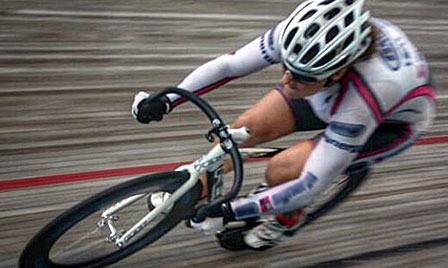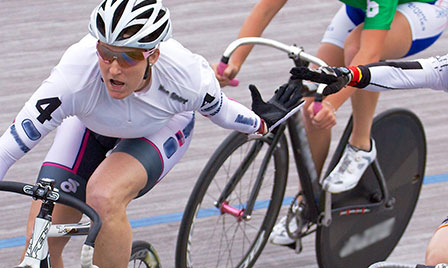How did you start track cycling?
A friend of mine from graduate school invited me to the velodrome at the National Sports Center to watch Thursday night racing. I was a spectator a handful of times before attending an introductory women's track night later that spring. As the experienced cyclists taught me to navigate my bike through the steep turns of
the velodrome, I fell in love with this obscure sport. Four weeks after completing the introductory track class, I raced my bike for the first time on the velodrome.
What is it like to ride on the velodrome?
The velodrome in Blaine is one of just three outdoor wooden tracks in the United States. The structure is a 250 meter oval that is banked 11 degrees on the straights and 43 degrees in the turns. When you stand on the grassy infield of the track, the
banking looks like a daunting vertical wall. The riding surface is marked with colored lines to define lanes and boundaries for racing. For new riders, it's a rite of passage to ride each line with your bike as you progress higher and higher on the banking. Flying around the track at speed is like riding a
self-propelled roller coaster.

How fast do racers go on the track?
To overcome the forces of gravity, it is necessary to ride at a minimum of 16 mph. Keep in mind that the rolling resistance on the track is less than on asphalt, which means it is easier to go 16 mph on the track than it is on the road. Longer endurance
races (50-80 laps) will average between 22 and 27 mph, while shorter sprint races (two to eight laps) may surge to over 40 mph.
What kind of equipment is used at these speeds?
A track bicycle is very specialized. Our bikes have only one gear and it is fixed, meaning that if the bike is moving the pedals are turning. We can't coast. Also, there are no brakes on a track bike. Riders must use the banking or apply a backward pressure to the pedals to slow the bike. Finally, the most important piece of
equipment is a helmet, required for all riding and racing.

You're a competitive track cyclist. What does
the 2016 season look like for you?
The season starts in mid-May and consists of 16 weeks of racing on Thursday nights at the NSC Velodrome in Blaine. I'll race at master's nationals in Indiana in August. Then in October, I'll compete at the Track Cycling Masters World Championships in
England. There, I'll race against women in my age bracket from around the world and attempt to break the world record in the 200m time trial.
What is your favorite part of track cycling?
Racing is always incredible. I find it really exhilarating. With up to 24 people in a race, we are elbow-to-elbow, jockeying for position at high speeds. I use all my senses and read the body language of my competitors to anticipate the next attack, trying to stay one
move ahead.
What I truly love the most are the friendships that I've developed on the infield and sharing my track craft with others. I teach nine to 12 years olds in the Velokids cycling program. It's a four-week camp where kids learn track safety and etiquette,
standing start technique and group riding skills. At the end of the program, the kids have a grand finale race in front of our Thursday Night Lights audience.
Do you have advice for anyone interested in
track cycling?
The velodrome is an incredibly empowering place. If you can ride a bicycle, you can learn track cycling. There are introductory classes for adults and kids to teach cycling skills and strategies in a controlled environment. We will help you become race
ready, if that is your goal, but most people who complete the intro class choose not to race. Finally track cycling is a great spectator sport. If you'd rather cheer than ride, you can start how I did, watching the Thursday Night Lights races at 7 p.m. in the summer.








